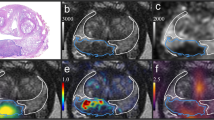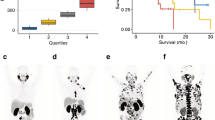Abstract
Purpose
Malignant de novo lipogenesis is strongly linked to the aggressiveness of prostate cancer (PCa) under experimental conditions. 11C-Acetate PET/CT is a potential noninvasive biomarker of malignant lipogenesis in PCa, but its prognostic value is not known. The objective of this study was to analyse 11C-acetate PET/CT image metrics in relation to survival.
Methods
All patients undergoing 11C-acetate PET/CT in one university hospital from 2005 to 2011 due to PSA relapse after previous prostatectomy were retrospectively evaluated. Two groups of patients were compared: those who died from PCa and those who were censored. All previously reported findings of local recurrence, regional or distal lymph node metastases and bone metastases were counted and evaluated regarding 11C-acetate uptake intensity (SUVmax) and tumour volume. Total tumour volume and total lipogenic activity (TLA, summed SUVmax × TV) were calculated. Survival analysis in the entire study population was followed by Cox proportional hazards ratio (HR) analysis.
Results
A total of 121 patients were included, and 22 PCa-specific deaths were recorded. The mean PSA level at the time of PET was 2.69 ± 4.35 ng/mL. The median follow-up of the study population was 79 ± 28 months. PET identified at least one PCa lesion in 53 % of patients. Five-year PCa-specific survival after PET was 80 % and 100 % in patients with a positive and a negative PET scan, respectively (p < 0.001). Time-to-death was linearly correlated with highest SUVmax (r = −0.55, p = 0.01) and nonlinearly with TLA (r = −0.75, p < 0.001). Multivariate analysis showed statistical significance for number of bone metastases (HR 1.74, p = 0.01), tertile of TLA (HR 5.63, p = 0.029) and postoperative Gleason score (HR 1.84, p = 0.045).
Conclusion
Malignant 11C-acetate accumulation measured with PET/CT is a strong predictor of survival in the setting of PSA relapse after prostatectomy. The study provides further evidence for a quantitative relationship between malignant de novo lipogenesis and early death. 11C-Acetate PET/CT might be useful for identifying a high-risk population of relapsing patients in which therapies targeting malignant lipogenesis might be of particular benefit.



Similar content being viewed by others
References
Sia M, Pickles T, Morton G, Souhami L, Lukka H, Warde P. Salvage radiotherapy following biochemical relapse after radical prostatectomy: proceedings of the Genito-Urinary Radiation Oncologists of Canada Consensus Meeting. Can Urol Assoc J. 2008;2(5):500–7.
Miyake M, Tanaka N, Asakawa I, Morizawa Y, Anai S, Torimoto K, et al. Proposed salvage treatment strategy for biochemical failure after radical prostatectomy in patients with prostate cancer: a retrospective study. Radiat Oncol. 2014;9:208.
Punnen S, Cooperberg MR, D’Amico AV, Karakiewicz PI, Moul JW, Scher HI, et al. Management of biochemical recurrence after primary treatment of prostate cancer: a systematic review of the literature. Eur Urol. 2013;64(6):905–15.
Stephenson AJ, Scardino PT, Kattan MW, Pisansky TM, Slawin KM, Klein EA, et al. Predicting the outcome of salvage radiation therapy for recurrent prostate cancer after radical prostatectomy. J Clin Oncol. 2007;25(15):2035–41.
Trock BJ, Han M, Freedland SJ, Humphreys EB, DeWeese TL, Partin AW, et al. Prostate cancer-specific survival following salvage radiotherapy vs observation in men with biochemical recurrence after radical prostatectomy. JAMA. 2008;299(23):2760–9.
Oyama N, Akino H, Kanamaru H, Suzuki Y, Muramoto S, Yonekura Y, et al. 11C-Acetate PET imaging of prostate cancer. J Nucl Med. 2002;43(2):181–6.
Oyama N, Miller TR, Dehdashti F, Siegel BA, Fischer KC, Michalski JM, et al. 11C-acetate PET imaging of prostate cancer: detection of recurrent disease at PSA relapse. J Nucl Med. 2003;44(4):549–55.
Buchegger F, Garibotto V, Zilli T, Allainmat L, Jorcano S, Vees H, et al. First imaging results of an intraindividual comparison of 11C-acetate and 18F-fluorocholine PET/CT in patients with prostate cancer at early biochemical first or second relapse after prostatectomy or radiotherapy. Eur J Nucl Med Mol Imaging. 2014;41(1):68–78.
Kotzerke J, Volkmer BG, Glatting G, van den Hoff J, Gschwend JE, Messer P, et al. Intraindividual comparison of [11C]acetate and [11C]choline PET for detection of metastases of prostate cancer. Nuklearmedizin. 2003;42(1):25–30.
Vāvere AL, Kridel SJ, Wheeler FB, Lewis JS. 1-11C-Acetate as a PET radiopharmaceutical for imaging fatty acid synthase expression in prostate cancer. J Nucl Med. 2008;49(2):327–34.
Yoshii Y, Furukawa T, Oyama N, Hasegawa Y, Kiyono Y, Nishii R, et al. Fatty acid synthase is a key target in multiple essential tumor functions of prostate cancer: uptake of radiolabeled acetate as a predictor of the targeted therapy outcome. PLoS One. 2013;8(5):e64570.
Le Bars D, Malleval M, Bonnefoi F, Tourvieille C. Simple synthesis of [1-11C]acetate. J Labelled Comp Radiopharm. 2006;49(3):263–7.
Morris MJ, Scher HI. (11)C-acetate PET imaging in prostate cancer. Eur J Nucl Med Mol Imaging. 2007;34(2):181–4.
Sandblom G, Sorensen J, Lundin N, Haggman M, Malmstrom PU. Positron emission tomography with C11-acetate for tumor detection and localization in patients with prostate-specific antigen relapse after radical prostatectomy. Urology. 2006;67(5):996–1000.
Kotzerke J, Volkmer BG, Neumaier B, Gschwend JE, Hautmann RE, Reske SN. Carbon-11 acetate positron emission tomography can detect local recurrence of prostate cancer. Eur J Nucl Med Mol Imaging. 2002;29(10):1380–4.
Albrecht S, Buchegger F, Soloviev D, Zaidi H, Vees H, Khan HG, et al. (11)C-acetate PET in the early evaluation of prostate cancer recurrence. Eur J Nucl Med Mol Imaging. 2007;34(2):185–96.
Wachter S, Tomek S, Kurtaran A, Wachter-Gerstner N, Djavan B, Becherer A, et al. 11C-acetate positron emission tomography imaging and image fusion with computed tomography and magnetic resonance imaging in patients with recurrent prostate cancer. J Clin Oncol. 2006;24(16):2513–9.
Haseebuddin M, Dehdashti F, Siegel BA, Liu J, Roth EB, Nepple KG, et al. 11C-acetate PET/CT before radical prostatectomy: nodal staging and treatment failure prediction. J Nucl Med. 2013;54(5):699–706.
Schumacher MC, Radecka E, Hellstrom M, Jacobsson H, Sundin A. [11C]Acetate positron emission tomography-computed tomography imaging of prostate cancer lymph-node metastases correlated with histopathological findings after extended lymphadenectomy. Scand J Urol. 2015;49(1):35–42.
Daouacher G, von Below C, Gestblom C, Ahlström H, Grzegorek R, Wassberg C, et al. Laparoscopic extended pelvic lymph node dissection as validation of the performance of [11C]-acetate-PET/CT in detection of lymph node metastasis in intermediate and high-risk prostate cancer. BJU Int. 2016;118(1):77–83.
Mohsen B, Giorgio T, Rasoul ZS, Werner L, Ali GR, Reza DKV, et al. Application of 11C-acetate positron-emission tomography (PET) imaging in prostate cancer: systematic review and meta-analysis of the literature. BJU Int. 2013;112(8):1062–72.
Freedland SJ, Humphreys EB, Mangold LA, Eisenberger M, Partin AW. Time to prostate specific antigen recurrence after radical prostatectomy and risk of prostate cancer specific mortality. J Urol. 2006;176(4):1404–8.
Freedland SJ, Humphreys EB, Mangold LA, Eisenberger M, Dorey FJ, Walsh PC, et al. Risk of prostate cancer-specific mortality following biochemical recurrence after radical prostatectomy. JAMA. 2005;294(4):433–9.
Leisser A, Pruscha K, Ubl P, Wadsak W, Mayerhöfer M, Mitterhauser M, et al. Evaluation of fatty acid synthase in prostate cancer recurrence: SUV of [11C]acetate PET as a prognostic marker. Prostate. 2015;75(15):1760–7.
Rossi S, Graner E, Febbo P, Weinstein L, Bhattacharya N, Onody T, et al. Fatty acid synthase expression defines distinct molecular signatures in prostate cancer. Mol Cancer Res. 2003;1(10):707–15.
Dimitrakopoulou-Strauss A, Strauss LG. PET imaging of prostate cancer with 11C-acetate. J Nucl Med. 2003;44(4):556–8.
Spick C, Polanec SH, Mitterhauser M, Wadsak W, Anner P, Reiterits B, et al. Detection of bone metastases using 11C-acetate PET in patients with prostate cancer with biochemical recurrence. Anticancer Res. 2015;35(12):6787–91.
Castellucci P, Jadvar H. PET/CT in prostate cancer: non-choline radiopharmaceuticals. Q J Nucl Med. 2012;56(4):367–74.
Fricke E, Machtens S, Hofmann M, van den Hoff J, Bergh S, Brunkhorst T, et al. Positron emission tomography with 11C-acetate and 18F-FDG in prostate cancer patients. Eur J Nucl Med Mol Imaging. 2003;30(4):607–11.
Oyama N, Tanase K, Ito H, Kusukawa N, Matsuta Y, Aoki Y, et al. 11C-Acetate PET imaging of recurrent prostate cancer after radical prostatectomy: detection of recurrent disease under PSA of 3.0 ng/ml. J Urol. 2010;183(4 Suppl):e792.
Giovacchini G, Picchio M, Garcia-Parra R, Briganti A, Abdollah F, Gianolli L, et al. 11C-choline PET/CT predicts prostate cancer-specific survival in patients with biochemical failure during androgen-deprivation therapy. J Nucl Med. 2014;55(2):233–41.
Giovacchini G, Incerti E, Mapelli P, Kirienko M, Briganti A, Gandaglia G, et al. [(11)C]Choline PET/CT predicts survival in hormone-naive prostate cancer patients with biochemical failure after radical prostatectomy. Eur J Nucl Med Mol Imaging. 2015;42(6):877–84.
Krause BJ, Souvatzoglou M, Tuncel M, Herrmann K, Buck AK, Praus C, et al. The detection rate of [11C]choline-PET/CT depends on the serum PSA-value in patients with biochemical recurrence of prostate cancer. Eur J Nucl Med Mol Imaging. 2008;35(1):18–23.
Giovacchini G, Picchio M, Coradeschi E, Bettinardi V, Gianolli L, Scattoni V, et al. Predictive factors of [11C]choline PET/CT in patients with biochemical failure after radical prostatectomy. Eur J Nucl Med Mol Imaging. 2010;37(2):301–9.
Flavin R, Zadra G, Loda M. Metabolic alterations and targeted therapies in prostate cancer. J Pathol. 2011;223(2):283–94.
Jadvar H, Desai B, Ji L, Conti PS, Dorff TB, Groshen SG, et al. Baseline 18F-FDG PET/CT parameters as imaging biomarkers of overall survival in castrate-resistant metastatic prostate cancer. J Nucl Med. 2013;54(8):1195–201.
Acknowledgments
The authors express sincere thanks to the Uppsala PET Centre staff for their dedicated efforts.
Author information
Authors and Affiliations
Corresponding author
Ethics declarations
Funding
This work was supported by the Swedish Cancer Foundation (CAN 2014/827).
Conflicts of interest
None.
Ethical approval
All procedures performed in studies involving human participants were in accordance with the ethical standards of the institutional and national research committee and with the principles of the 1964 Declaration of Helsinki and its later amendments. Ethical approval for this retrospective study was obtained from the Institutional ethical review board at the Department of Oncology (Dnr IRB 5/2015).
Informed consent
The need for individual patient consent was waived.
Electronic supplementary material
Below is the link to the electronic supplementary material.
ESM 1
(DOCX 683 kb)
Rights and permissions
About this article
Cite this article
Regula, N., Häggman, M., Johansson, S. et al. Malignant lipogenesis defined by 11C-acetate PET/CT predicts prostate cancer-specific survival in patients with biochemical relapse after prostatectomy. Eur J Nucl Med Mol Imaging 43, 2131–2138 (2016). https://doi.org/10.1007/s00259-016-3449-7
Received:
Accepted:
Published:
Issue Date:
DOI: https://doi.org/10.1007/s00259-016-3449-7




